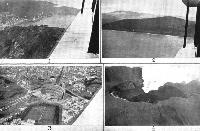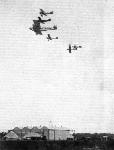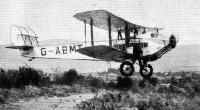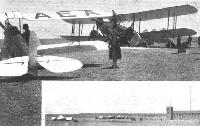
Описание
Страна : Великобритания
Год : 1926
Транспортно-пассажирский самолет с экипажем из трех человек
de Havilland DH.66 Hercules
Устаревшие самолеты DH.10, возившие авиапочту между Каиром и Багдадом, нуждались в замене. По договору 1925 года с авиакомпанией "Imperial Airways" был создан соответствующий новым требованиям трехмоторный биплан DH.66 Hercules.
Его прототип впервые поднялся в воздух 30 сентября 1926 года, вскоре после получения от "Imperial Airways" заказа на пять самолетов. Он быстро прошел испытания и был доставлен в Каир уже к середине декабря. Полет, открывший воздушное сообщение из Кройдона в Дели, стартовал в Британии 27 декабря и завершился в Индии 8 января 1927 года. Пятый самолет доставили в Каир в марте. Характеристики этих самолетов впечатлили компанию "West Australia Airways" (WAA), которая эксплуатировала машины DH.50. Она заказала четыре экземпляра Hercules. Первый из них полетел в марте 1929 года, а 2 июня машины этого типа начали обслуживать авиалинию WAA между Пертом и Аделаидой. К тому времени "Imperial Airways" заказала шестой, а затем и седьмой самолеты этого типа, поступившие заказчику в феврале 1930 года.
Шестой Hercules имел закрытую пилотскую кабину, что в дальнейшем стало стандартом на остальных машинах. Последние два Hercules потребовались авиакомпании после потери трех самолетов в летных происшествиях с сентября 1929 по апрель 1931 года, одно из которых сопровождалось человеческими жертвами.
В 1930-1931 годах "Imperial Airways" выкупила два Hercules у компании WAA. Один из них разбился в Южной Родезии в ноябре 1935-го. Остальные в декабре 1935 года были списаны и проданы в ЮАР. Их дальнейшая судьба неизвестна. Самым долгоживущим Hercules стал, вероятно, один из самолетов, ранее принадлежавших WAA - он прослужил на Новой Гвинее до 1942 года и был уничтожен японцами.
ТАКТИКО-ТЕХНИЧЕСКИЕ ХАРАКТЕРИСТИКИ
de Havilland DH.66 Hercules
Тип: транспортно-пассажирский самолет с экипажем из трех человек
Силовая установка: три звездообразных поршневых мотора Bristol Jupiter VI мощностью по 420 л.с. (313 кВт)
Летные характеристики: максимальная скорость 206 км/ч на оптимальной высоте; крейсерская скорость 177 км/ч на оптимальной высоте; начальная скороподъемность 233 м/мин; практический потолок 3960 м; дальность полета 845 км
Масса: пустого самолета 4110 кг; максимальная взлетная 7076 кг
Размеры: размах крыльев 16,92 м; длина 16,92 м; высота 5,56 м; площадь крыльев 143,72 м2
Полезная нагрузка: до 14 пассажиров и почта
Описание:
- de Havilland DH.66 Hercules
- Flight, June 1926
A NEW DE HAVILLAND COMMERCIAL AEROPLANE - Flight, November 1926
A NEW MACHINE FOR EMPIRE AVIATION
Фотографии
-
Мировая Авиация 104
Регистрационный номер: G-AAJH [2] DH.66 был оборудован багажным отсеком объемом 4,39 м3, отсеком для авиапочты объемом 13,17м1 и салоном для семи пассажиров. Экипаж состоял из трех человек.
-
Flight 1926-11 / Flight
Регистрационный номер: G-EBMW [10] THE DE HAVILLAND 66 "HERCULES": Fitted with three Bristol "Jupiter VI" engines this type of machine is intended for the Cairo-Karachi air route which is to come into operation early in 1927. The Secretary of State for Air, Sir Samuel Hoare, who will be accompanied by Lady Maud Hoare, will be one of the passengers in the first machine to fly out to the East. A detailed description, with general arrangement drawings and sketches of constructional details, was published in our issue of June 10, 1926.
-
Aeroplane Monthly 1977-12 / Personal album
Регистрационный номер: G-EBMW [10] The prototype D.H.66 Hercules, G-EBMW, was first flown on September 30, 1926. Unlike the production batch the prototype featured an open pilot’s cockpit. 'MW was operated by Imperial Airways and was named City of Cairo. In April 1931 it left for the Far East on an experimental air mail flight, but on April 19 it ran short of fuel and was wrecked in the ensuing forced landing at Koepang.
-
Flight 1926-11 / Flight
Регистрационный номер: G-EBMW [10] THE DE HAVILLAND 66 "HERCULES' : Side View. Note the three rudders and the biplane tail. The protruberance aft of the pilot's cockpit is the fresh-air intake for the cabin. Mounted next to it is the Bristol engine starter by means of which the three main Bristol "Jupiter" engines are started.
-
Flight 1931-10 / Flight
Регистрационный номер: G-EBMW [10] THE DE HAVILLAND 66, "HERCULES": A three-engined (Bristol "Jupiter VI") biplane used on the Middle-East route.
-
Aeroplane Monthly 1986-11 / J.Stroud - Wings of Peace
Регистрационный номер: G-EBMW [10] The first D.H.66 during an early test flight.
-
Flight 1939-06 / Flight
Регистрационный номер: G-EBMW [10] D.H.66 Hercules, G-EBMW, later to be named City of Cairo, makes a test flight from Stag Lane aerodrome.
The D.H.66, or Hercules, a somewhat similar type to Armstrong Whitworth Argosy, ordered and delivered at much the same time for the Empire routes, which were then being planned. -
Flight 1926-12 / Flight
Регистрационный номер: G-EBMW [10] The de Havilland "Hercules" in flight. Five of these machines, fitted with three Bristol "Jupiters," are being built for the desert air route from Cairo to Karachi. The "Hercules" will take off fully loaded with only two engines running, and only loses height slightly flying on one engine.
-
Flight 1926-11 / Flight
Регистрационный номер: G-EBMW [10] THE CAIRO-KARACHI AIR ROUTE: Two aerial views of the de Havilland "Hercules," with three Bristol "Jupiter" engines, taken during a test flight in the neighbourhood of Stag Lane Aerodrome.
-
Flight 1927-01 / Flight
Регистрационный номер: G-EBMX [6] THE "CITY OF DELHI": These three views show the actual de Havilland "Hercules," with three Bristol "Jupiter" engines, on which Sir Samuel and Lady Maud Hoare and Air Vice-Marshal Sir Geoffrey Salmond made the flight from London to India. Upon its arrival the machine was christened "City of Delhi."
-
Aeroplane Monthly 1988-03 / Personal album. Civil
Регистрационный номер: G-EBMX [6] The second D.H.66 Hercules, G-EBMX, was built at Stag Lane in 1926 for Imperial Airways. Named City of Delhi, 'MX made the inaugural flight on the desert route between Cairo and Karachi, leaving Croydon on December 26, 1926 and arriving at Delhi on January 8, 1927, where the naming ceremony was carried out. In November 1934 ’MX was sold to the South African Air Force as Serial No 262 and was finally dismantled for spares at Broken Hill in November 1939.
-
Aeroplane Monthly 1986-11 / J.Stroud - Wings of Peace
Регистрационный номер: G-EBMX [6] The first Imperial Airways aeroplane in India, G-EBMX at Delhi in January 1927.
-
Jane's All the World Aircraft 1980 / Encyclopedia of Aviation - 1. Chronology
Регистрационный номер: G-EBMX [6] Imperial Airways Hercules (30 March 1929).
-
Flight 1926-12 / Flight
Регистрационный номер: G-EBMX [6] THE FIRST IMPERIAL AIR ROUTE: Out of the darkness into sunshine. The lower picture was taken in the early hours of Monday morning just before the inaugural flight to India, and shows a small crowd of enthusiasts, who braved the bitter cold, gathered at Croydon to give Sir Samuel Hoare a hearty send-off. Above, the "Hercules" taken from another machine (at 7000 ft.) a few days previously.
-
Flight 1937-05 / Flight
THE FIRST IMPERIAL AIR ROUTE: This photograph was taken at Croydon just before the start; standing beside the D.H. "Hercules" (from left to right) are Capt. F. L. Barnard (pilot), Lady Maud Hoare, Sir Samuel Hoare, Sir Eric Geddes, Sir Samuel Instone, Mr. Bullock, and Air Vice-Marshal Sir Vyell Vyvyan.
-
Flight 1927-04 / Flight
THE FLIGHT TO EGYPT: A set of pictures secured by Capt. Geoffrey de Havilland on his recent flight to the East in a "Hercules." 1 is an aerial view of Monaco, while 2 shows a glimpse of the coast of north-western Italy. A bird's eye view of the Collosseum in Rome is given in 3, and the crater of Vesuvius in 4.
-
Flight 1927-04 / Flight
THE FLIGHT TO EGYPT: A further set of pictures showing, 1, view on the east coast of Sicily; 2, lady passengers standing by the "Hercules" on Sollum aerodrome; 3, refuelling the "Hercules" at Sollum; 4, one of the Pyramids from above, and 5, the "Hercules" in front of the new hangar at Heliopolis.
-
Aeroplane Monthly 1982-07 / P.Capon - Capon's Corner
Регистрационный номер: G-EBMY [3] One of the largest aircraft built at Stag Lane was the D.H.66 Hercules passenger transport. The second aircraft, G-EBMY, is seen at Stag Lane in November 1926, shortly after it was built. The D.H.66 carried seven passengers and three crew and was powered by three 420 h.p. Bristol Jupiter VI engines.
-
Jane's All the World Aircraft 1980 / Encyclopedia of Aviation - Aircraft A-Z - v3
Регистрационный номер: G-EBMY [3] de Havilland D.H.66 Hercules.
-
Aeroplane Monthly 1986-11 / J.Stroud - Wings of Peace
Регистрационный номер: G-EBMY [3] G-EBMY at Pisa during its delivery flight to Cairo in December 1926.
-
Aeroplane Monthly 1988-03 / Personal album. Civil
Регистрационный номер: G-EBMZ The fourth D.H.66 Hercules, G-EBMZ, was registered to Imperial Airways in 1927 and named City of Jerusalem. On the night of September 6, 1929, ’MZ stalled while approaching Jask in Persia and was destroyed by fire, killing pilot Capt Woodbridge and two passengers. Eleven of these seven-passenger airliners were built. They were powered by three 420 h.p. Bristol Jupiter VI radial engines and had a cruising speed of 110 m.p.h.
-
Aeroplane Monthly 1986-11 / J.Stroud - Wings of Peace
Регистрационный номер: G-EBNA G-EBNA, last of the original five Imperial Airways D.H.66s, at Stag Lane in 1927.
-
Flight 1929-04 / Flight
THE AIR ROUTE TO INDIA: The D.H. "Hercules" (three Bristol "Jupiters"), the type which will operate the Egypt-India section.
-
Aeroplane Monthly 1986-11 / J.Stroud - Wings of Peace
Регистрационный номер: G-AUJO G-AUJO, the first D.H.66 for West Australian Airways, on test from Stag Lane in March or April 1929. It has an enclosed cockpit and a tailwheel, and in this view the port engine is shut down.
-
Flight 1930-01 / Flight
The D.H. Hercules.
-
Flight 1940-09 / Flight
The D.H.66 (Hercules) had three Bristol Jupiter engines.
-
Aeroplane Monthly 1999-09 / D.Lang - All-Weather Mac /Masters of the air/ (1)
Регистрационный номер: G-AAJH [2] “First Imperial Airways machine to carry mail to Johannesburg. Christmas mail going down to Johannesburg, taken from 'JO near Bulawayo” was the Hon Mrs Westenra’s description of this photograph. This most historic air-to-air photograph of the first through airmail service from London to Cape Town in 1931 shows Imperial Airways D.H.66 Hercules G-AAJH City of Basra, piloted by Capt Attwood, on December 19, 1931, about 400 miles north of Johannesburg. On its arrival there, the new Germiston Airport was officially opened and the mail, with the exception of five bags for the Rand, was transferred to Imperial Airways D.H.66 G-AARY City of Karachi to be flown on to Cape Town by Capt Alger, Capt Caspareuthus and Maj Brackley.
Другие самолёты на фотографии: De Havilland Puss Moth / D.H.80 - Великобритания - 1929
-
Flight 1932-12 / Flight
THE CIRCUS AT THE CAPE: Six of Sir Alan Cobham's machines flying in formation, led by the D.H.66, over Cape Town.
-
Flight 1932-12 / Flight
Регистрационный номер: G-ABMT THE CIRCUS AT THE CAPE: The D.H. 66 lands, apparently in rough ground, at the Cape Airport. Actually, the surface of the aerodrome is quite smooth.
-
Flight 1932-01 / Flight
Регистрационный номер: G-AARY [5] THE CAPE AIR MAIL: Imperial Airways D.H. "Hercules," City of Karachi, arriving at Capetown on December 21 with the special Xmas air mail direct from England. The mail left Croydon on December 9.
-
Авиация и Космонавтика 2018-09 / В.Морозов - В желтой, жаркой Африке: Авиация Родезии и Зимбабве (1)
Де Хэвиленд DH.66 «Геркулес» британской авиакомпании «Imperial Airways». Именно на таких самолетах в 1931 г. были выполнены первые регулярные пассажирские рейсы из Лондона в Кейптаун и в Солсбери
-
Flight 1929-02 / Flight
THREE-ENGINED AEROPLANES FOR AUSTRALIA: The first "Hercules" of a batch ordered by Western Australia Airways having her Bristol "Jupiter" engines "run up." Note the tail wheel fitted instead of the usual tail skid.
-
Aeroplane Monthly 1974-03 / P.Moss - Wings for the Empire (3)
Регистрационный номер: G-ABCP [2] G-ABCP being refuelled at Cape Town in February 1932.
D.H.66, G-ABCP, Stad van Jodhpur, was damaged beyond repair when taking off from Salisbury, Rhodesia in November 1935. -
Flight 1930-11 / Flight
De Havilland Hercules passenger carrier (three Bristol Jupiters)
-
Aeroplane Monthly 1986-11 / J.Stroud - Wings of Peace
Регистрационный номер: G-ABCP [2] G-ABCP City of Jodhpur, probably at Heliopolis.
-
Aeroplane Monthly 1986-11 / J.Stroud - Wings of Peace
Регистрационный номер: G-AARY [5] G-AARY City of Karachi at Zomba, Nyasaland (now Malawi) during the Christmas mail flight to Cape Town in December 1931.
-
Aeroplane Monthly 1986-11 / J.Stroud - Wings of Peace
Регистрационный номер: G-AARY [5] D.H.66 G-AARY City of Karachi in service on the India route.
-
Air International 2002-06 / R.Whitford - Fundamentals of Airliner Design /Commercial/ (9)
Регистрационный номер: G-AARY [5] Replacing the earlier Jupiters’ cast aluminium crankcase with a forged one reduced the weight of the Jupiter VI by 7%. It was used on the DH.66 Hercules, with which Imperial Airways started its UK-India service, later extended to Australia.
-
Aeroplane Monthly 1974-03 / P.Moss - Wings for the Empire (3)
Регистрационный номер: G-EBMX [6] D.H.66 Hercules, G-EBMX, City of Delhi, being refuelled by hand. It was sold to the South African Air Force in company with two others in 1934.
-
Flight 1931-05 / Flight
Регистрационный номер: G-EBMW [10] THE FIRST AIR MAIL TO AUSTRALIA: The ill-fated DH "Hercules" City of Cairo, of Imperial Airways, with the mail for Australia, refuelling at Batavia. The machine, it will be remembered, crashed at Kupang shortly after.
-
Flight 1930-01 / Flight
FIRST KARACHI-DELHI AIR MAIL: Mail and freight being loaded in the Imperial Airways' "City of Delhi" D.H. "Hercules" air liner at Karachi, on the occasion of the opening of the extension of the England-India air route between Karachi and Delhi.
-
Flight 1932-01 / Flight
Регистрационный номер: G-AARY [5] THE CAPE AIR MAIL: The City of Karachi being docked at Capetown at the conclusion of the first (experimental) through air mail service from England.
-
Flight 1929-05 / Flight
This view marks the arrival of Mrs. Hylton Cleaver and Capt. Donald Drew in the former's Gipsy-Moth at Rutbah Wells on April 4 last, during their tour to India. Behind Mrs. Cleaver is the Imperial Airways D.H. "Hercules" (Bristol "Jupiters") "City of Jerusalem" refuelling during the first eastbound Indian Air Mail flight.
-
Air-Britain Aeromilitaria 1978-03
At the risk of appearing to over-emphasise airfields in this issue, the back cover photograph has been selected to illustrate one of the Royal Air Force's most famous overseas stations.
Lying between Cairo and the Suez Canal, Heliopolis was retained as a permanent station after the end of World War One when many Egyptian airfields closed down. It is perhaps best known as the home of the Victoria and Valentia bomber-transports which so typified the activities of the RAF in the Middle East between the wars. It also was a staging post on Imperial Airways routes to South Africa and the Far East.
In layout, it was typical of desert airfields in having its buildings clustered together within a perimeter fence. By tradition, the local inhabitants were assumed to be able to purloin anything not embedded in concrete, a much greater menace than air attack. At night, the gates were closed to leave only the landing ground open to stray visitors. In the photograph can be seen Fairey IIIFs and Atlases parked outside the wire while beside the large hangar sits a D.H.66 tri-motor of Imperial Airways. The three smaller hangars nearest to the large hangar were used by the airline and the RAF fence neatly loops back to allow them to guard their own property!
In the left background, safely isolated from the main camp, is the ammunition dump in its revetment and wired in separately.
The photograph was taken on 8 March 1929 by No.208 (Army Cooperation) Squadron.Другие самолёты на фотографии: Armstrong Whitworth Atlas / Ajax - Великобритания - 1925Fairey Fairey IIIF - Великобритания - 1926
-
Aeroplane Monthly 1979-04 / Stag Lane /Gone but not forgotten/ (1)
THE D.H.66: Three-quarter front view of the fuselage in skeleton. The main structure is of steel tube, and cabin, luggage compartment, etc., are in the form of "boxes" of three-ply, slipped into the main structure.
The prototype D.H.66 Hercules fuselage under construction, July 1926. -
Flight 1926-06 / Flight
THE D.H.66: The mounting for the central engine is extremely neat and simple. The engine plate is made of Duralumin and is very light. Details of this mounting are illustrated by sketches.
-
Aeroplane Monthly 1986-11 / J.Stroud - Wings of Peace
The cabin of an Imperial Airways D.H.66, looking aft.
-
Aeroplane Monthly 1986-11 / J.Stroud - Wings of Peace
Регистрационный номер: G-EBMW [10] KEITH WOODCOCK'S painting shows the de Havilland 66 Hercules G-EBMW, which opened the Basra - Baghdad - Cairo service in January 1927, over the Arch of Ctesiphon just south of Baghdad.
-
Flight 1926-06 / Flight
THE D.H.66: Sketch showing the triangulated structure in the lower plane, which carries one of the wing engines. The undercarriage struts are attached to the two fittings at front and rear ends of the longitudinal tube.
-
Flight 1926-06 / Flight
THE D.H.66: Some spar details. On the left, the distance-pieces separating the spar flanges in the inner bay, and on the right, the same, but in a slightly different form, in the end sections of the wing. The spars are of spruce, spindled out as indicated, and the distance-pieces are of laminated spruce, while the spar walls are of three-ply.
-
Flight 1926-06 / Flight
THE D.H.66: Some constructional details. 1, shows the fuselage joint at the point where are attached the front spar of the lower wing and the inner end of the wheel axle. 2 is another fuselage joint slightly farther aft. This sketch was made from a fuselage side lying on trestles, and the sloping strut is actually vertical, while the wiring plates visible below the longeron belong to the cross-bracing of the floor panel of the bay. The joints in the rear portion of the fuselage are of the type illustrated in 3. All the steel tube struts and longerons have Duralumin ends, forked or plain, according to local requirements. Some details of the mounting of the nose engine are shown in 4. The engine plate itself is of Duralumin and is very light. It should be pointed out that the sketch is a rear view, and shows the back of the engine plate.
-
Flight 1926-06 / Flight
D.H.66 3 Bristol "Jupiter" Engines
- Фотографии




















































